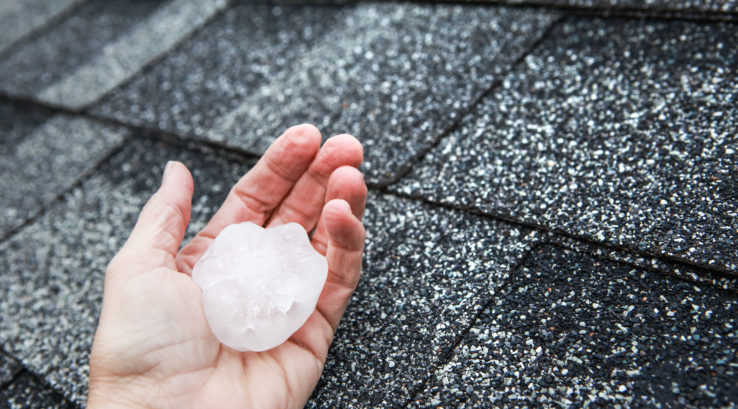With summer and early fall comes bright, sunny skies, but also, bouts of fearsome weather. Is your home protected against roof hail damage?
As it turns out, there are some noticeable signs that can tell you if your roof has been damaged by hail, is at risk — or both! Check out this blog, so you can identify hail damage that’s been done to your roof and make an informed decision about when to have it replaced.
Understanding the Dangers of Hail Damage
While the most severe and noticeable damage comes from hailstones the size of quarters or larger, even less violent storms can cause damage that builds up over time. As hail damage causes shingles to weaken and pull away from their backing, other issues may arise.
This loss in structural integrity can have a ripple effect on your entire roof. UV rays from the sun can cause exposed and unprotected areas of your roof to become brittle and more susceptible to leaks.
Your roof may also absorb more water from rain and snow when it’s damaged by a hail storm. In the winter, freezing might cause the water absorbed by the shingles to expand, damaging them even further. A damaged roof may reduce its ability to insulate the house, cause serious leaks, introduce mold into the house, and lead to electrical damage.
Essentially, hail damage can become a serious issue long before you notice it on your roof!
What Does Hail Damage Look Like on a Roof?
When heavier hail storms occur, roof damage is noticeable. High winds and large hailstones (the size of a half-dollar or more) can loosen the integrity of the seal holding shingles in place, sometimes punching holes through the outer shingle layers exposing your roof.
So, what does hail damage look like on a roof? The appearance of the damage depends on the quality of the material on your roof. For example, damage to asphalt and composite shingles may appear as punctures or tears, while hail damage to wooden shingles can appear as dents or splits with oxidation.
Since certain types of roofs make it harder to detect hail damage in the aftermath of a storm, the entire structure could be weakened, leaving your home unprotected
Other Signs of Roof Hail Damage
You could go on your roof and examine it after a hailstorm and still miss signs of damage. Here’s why.
If you have asphalt shingles, most hailstorms won’t cause noticeable damage, at least, not right away. On impact, these shingles lose tiny granules of their coating, becoming weaker and increasing the likelihood of leaks and insulation issues.
If you notice tiny black particles in your gutters or coming out of your downspouts, it’s a sign that it may be time to have your roof inspected.
So, You Have a Hail Damaged Roof: Now What?
By now, you know that hail damage to your roof could mean major — not to mention costly — problems for you and your family. Even minor damage can escalate quickly, causing leaks, electrical issues, and insulation problems. The only true solution is a brand-new roof. Fortunately, at Thompson Creek, we provide roof replacement.
Our experienced team designs and installs roofing systems using the industry’s best materials, covered by our No-Hassle Warranty. For a free consultation, contact us today.


